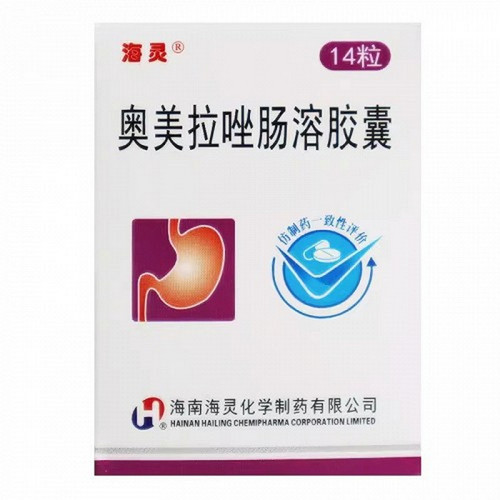Product Overview
[Drug Name]
Generic Name: Omeprazole Enteric-Coated Capsules
Trade Name: Omeprazole Enteric-Coated Capsules 20mg*21 Capsules
Pinyin Code: AoMeiLaZuoChangRongJiaoNang 20mg*21Li
[Main Ingredients]
The main ingredient of this product is omeprazole.
[Properties]
This product consists of white or off-white enteric-coated pellets or granules.
[Indications/Main Functions]
Indicated for gastric ulcers, duodenal ulcers, stress ulcers, reflux esophagitis, and Zollinger-Ellison syndrome (gastrinoma).
[Specifications]
20mg*21 capsules
[Dosage and Administration]
Oral administration; do not chew.
1. Peptic gastric ulcer: 20mg (one capsule at a time), 1-2 times daily. Take once daily in the morning or once in the morning and evening. The treatment course for gastric ulcers is usually 4-8 weeks, and for duodenal ulcers, 2-4 weeks. 2. Reflux esophagitis: 20-60 mg (1-3 tablets) once or twice daily. Take in the morning or once in the morning and evening. The course of treatment is usually 4-8 weeks.
3. Zollinger-Ellison syndrome:
60 mg (3 tablets) once daily. The total daily dose can be adjusted to 20-120 mg (1-6 tablets) depending on the condition. If the total daily dose exceeds 80 mg (4 tablets), it should be taken in two divided doses.
[Adverse Reactions]
This product is well tolerated. Possible adverse reactions include: 1. Digestive system: Dry mouth, mild nausea, vomiting, abdominal distension, constipation, diarrhea, and abdominal pain may occur; elevations in alanine aminotransferase (ALT), aspartate aminotransferase (AST), and bilirubin may occur, but these are generally mild and transient and do not affect treatment. Furthermore, international data have reported that gastric mucosal cell hyperplasia or atrophic gastritis may be observed in gastric biopsy specimens from patients receiving long-term omeprazole therapy. 2. Neuropsychiatric System: May experience paresthesia, dizziness, headache, drowsiness, insomnia, and peripheral neuritis. 3. Metabolic/Endocrine System: Long-term use of omeprazole may lead to vitamin B12 deficiency. 4. Other: May cause rash, gynecomastia, and hemolytic anemia.
[Contraindications]
This product is contraindicated in patients with allergies, severe renal insufficiency, and infants.
[Drug Interactions]
1. Omeprazole can create an alkaline environment in the stomach, reducing the absorption of drugs such as ketoconazole and itraconazole. 2. When omeprazole is used in combination with clarithromycin or erythromycin, their blood concentrations may increase. However, there is no interaction with metronidazole or amoxicillin. 3. Omeprazole has enzyme inhibitory effects. When used in combination with drugs metabolized by the hepatic cytochrome P450 system (CYP2C19), such as dicoumarol, warfarin, diazepam, and phenytoin, it can prolong the latter's half-life and slow their metabolism. 4. Omeprazole's acid-suppressing effect can affect iron absorption. 5. Omeprazole can alter gastric pH, thereby damaging sustained-release and controlled-release formulations and accelerating drug dissolution. 6. Drug interaction studies with other drugs have shown that daily oral administration of omeprazole (20-40 mg) does not affect other related CYP isoenzymes and has no metabolic interactions with the following enzyme substrates: CYP1A2 (caffeine, phenacetin, theophylline), CYP2C9 (S-warfarin, piroxicam, diclofenac, and naproxen), CYP2D6 (metoprolol, propranolol), CYP2E1 (ethanol), and CYP3A (lidocaine, quinidine, diethanolamine, and budesonide).
[Precautions]
1. Use with caution in patients with renal or severe hepatic impairment. 2. Effects of Drugs on Diagnosis: ① Omeprazole can inhibit gastric acid secretion, increasing gastric pH. This feedback loop triggers the secretion of gastrin by G cells in the gastric mucosa, leading to elevated blood gastrin levels. ② Omeprazole can cause false-negative results on the 13C-urea breath test (UBT). This mechanism may be due to omeprazole's direct or indirect inhibitory effect on Helicobacter pylori (H. pylori). Clinically, the 13C-urea breath test should be performed at least 4 weeks after omeprazole treatment. 3. Items that should be monitored before, during, and after medication use: ① Efficacy monitoring. When treating peptic ulcers, endoscopic examination should be performed to determine ulcer healing. When treating H. pylori-related peptic ulcers, a UBT test can be performed 4 to 6 weeks after treatment to determine whether H. pylori has been eradicated. When treating Zollinger-Ellison syndrome, basal gastric acid secretion should be measured to ensure it is less than 10 mEq/h (i.e., the treatment target). ② Toxicity monitoring. Liver function tests should be performed regularly. Long-term users should also have their gastric mucosa checked for tumor-like hyperplasia. Serum vitamin B12 levels should also be monitored for users taking the drug for more than three years. 4. When treating gastric ulcers, this drug should be used only after the possibility of cancer has been ruled out. This medication may alleviate symptoms and thus delay treatment. 5. To prevent excessive acid suppression, long-term, high-dose use of this drug is not recommended for the treatment of general peptic ulcers (except in the case of Zollinger-Ellison syndrome).
[Use in Elderly Patients]
Generally, this drug does not require dosage adjustment in the elderly, but should be used with caution.









